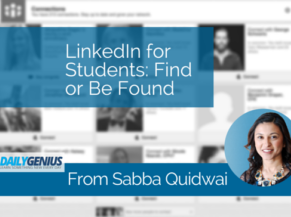This post first appeared on Daily Genius.
"Find and be found."
This should be the mantra for every student in secondary and postsecondary education.
When David Theriault, an English teacher at Fountain Valley High School in California, asked his students to put their resume together in a creative format and began talking to students about the importance of a digital portfolio, I’m sure Beverly Pham would not have predicted how this assignment would change her life. When the University of Southern California sent her a letter saying that she had not been accepted because her grades were not strong enough, she wrote back and replied, "Google Me." The admissions team at USC found through a quick Google search all of the work she had done based on her digital presence initiated in David Theriault’s class and accepted her to USC.
How many talented and passionate young students like Beverly go unnoticed because they didn’t have the guidance to navigate the digital era and create a digital portfolio?
In this crazy competitive search for jobs, students sometimes feel like they have to settle for what they are offered. They take low-paying internships, or whatever position will start paying off their student loans immediately after graduation. According to the New York Federal Reserve, 86 percent of students choose to attend college to get better jobs, but 44 percent of graduates are underemployed. If we want to empower students to find jobs they love instead of settling, they should have two things prepared before they graduate: A digital portfolio and a professional network.
How Students Can Do Both?
LinkedIn, the world's largest professional network with hundreds of millions of members, provides everyone an opportunity to develop a digital portfolio and a professional learning network. Students get a chance to meet influential people in their field while they are still in school, and each of these individuals can easily become a part of a student’s professional learning network. Furthermore, LinkedIn not only allows someone to build a valuable network but also provides a digital space accessible to anyone from their personal computer to bring experiences and stories to life. It allows users to attach a variety of file types and links to directly connect the audience with the projects, stories, and work that an individual has created. Even more so, LinkedIn is a platform to write articles and participate in discussions with other like-minded professionals, giving students easy access to a community that will further enhance their professional network.
To complement their platform, LinkedIn introduced LinkedIn Student (iOS and Android). This new tool helps students learn more about careers related to their major, discover where alumni may be working, and ultimately allows them to discover new opportunities.
Not everyone has teachers who stress the importance of portfolios and networking, so to help students create a great profile and understand how to maximize their use of the platform, LinkedIn even created a Student Job Hunting Handbook series.
Creating a Professional Learning Network
While many other platforms allow you to create a website and highlight your work, LinkedIn is one of the few places that brings together the opportunity to showcase your work and be part of a professional learning network. When Sadia Quidwai graduated from the Keck School of Medicine Physician Assistant Program at USC, she never imagined that she would be getting married and moving to another country. One of Sadia’s greatest concerns was finding a job in London because the physician assistant profession is relatively new. Because her program had prepared her with a strong online portfolio using LinkedIn, she was able to land a position at the top hospital in London, Guy's and St. Thomas’, in her ideal specialization - Orthopedics.
Sadia’s advice to students, “Get onto social media because you can make the most amazing connections with the most amazing people plus find out all the information you want. Everyone is on Twitter and LinkedIn. That is how I got my job and how I made connections. I did my interview, my application, and everything from California. I only flew out when I was planning to relocate here and start my job in the hospital. I would say that is key when starting a career.”
Through creating a digital portfolio and professional learning network with LinkedIn, all of our students can have a platform that serves as a spotlight on who they are beyond the measurements we often use to categorize them. No longer should students be limited to the options on a job board, but they should be empowered to create a presence that allows them to find and be found. They don’t have to wait to hear back from applying for a position because they can identify the position they want based on their connections and experience.
Do you have any stories about the success your students have had in creating portfolios? How do you support students so they can find and be found? We'd love to hear them.
Learn more from Sabba this summer in San Francisco or join Suzy Brooks in Boston to discover new ways to empower students with digital portfolios.


